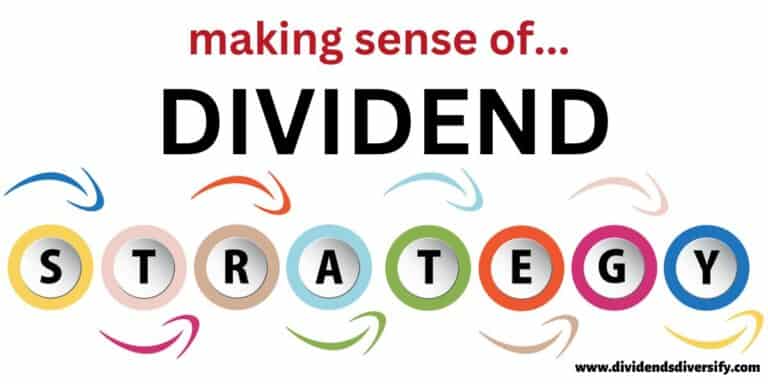The Power Of Simplicity In Dividend Investing

Table of Contents
Identifying High-Quality Dividend Stocks for Simplicity
Choosing the right dividend stocks is crucial. Focusing on quality over quantity simplifies the process significantly.
Focus on Established, Financially Strong Companies
- Long History of Dividend Payments: Look for companies with a proven track record of consistent dividend payouts, ideally spanning several decades. This demonstrates financial stability and a commitment to returning value to shareholders.
- Consistent Dividend Growth: Prioritize companies that have a history of increasing their dividend payments over time. A steady growth rate signals a healthy and growing business.
- Strong Balance Sheets: Examine key financial metrics like payout ratios (the percentage of earnings paid out as dividends), dividend growth rates, and debt-to-equity ratios. Lower debt and a sustainable payout ratio indicate a company's ability to maintain its dividend payments even during economic downturns.
- Utilize Free Resources: Websites like Yahoo Finance, Google Finance, and Morningstar provide access to essential financial data. Consider using free stock screeners to filter for companies meeting your specific criteria.
Avoid "dividend traps"—high-yield stocks from financially weak companies that may cut or eliminate their dividends unexpectedly. These can lead to significant losses.
Simplify Your Research Process
Don't get bogged down in endless detailed analysis. Focus on a few key metrics:
- Dividend Yield: This indicates the annual dividend payment relative to the stock price.
- Payout Ratio: This shows the percentage of earnings paid out as dividends. A sustainable payout ratio is generally below 70%.
- Debt-to-Equity Ratio: This measures a company's financial leverage. A lower ratio indicates less reliance on debt.
By simplifying your screening criteria to a manageable number of stocks and focusing on these key metrics, you can efficiently identify promising dividend investments. Remember, a well-diversified portfolio is crucial for mitigating risk.
Building a Simple, Diversified Dividend Portfolio
Building a diverse portfolio doesn't require complex strategies. Simplicity is key.
The Power of Index Funds and ETFs
Index funds and exchange-traded funds (ETFs) offer instant diversification and simplicity:
- Instant Diversification: These funds invest in a basket of stocks, instantly diversifying your investment across various sectors and companies, reducing risk.
- Low Costs: Index funds and ETFs generally have lower expense ratios than actively managed funds.
- Dividend-Focused Funds: Many index funds and ETFs specifically target dividend-paying stocks, simplifying your selection process. Examples include the Vanguard Dividend Appreciation ETF (VIG) or the Schwab US Dividend Equity ETF (SCHD).
Passive investing through index funds is often more effective than attempting to beat the market through active stock picking.
Dollar-Cost Averaging (DCA) for Consistent Growth
Dollar-cost averaging is a simple yet powerful strategy:
- Mitigate Risk: Invest a fixed amount of money at regular intervals (e.g., monthly or quarterly), regardless of market fluctuations. This reduces the risk of investing a lump sum at a market peak.
- Disciplined Investing: DCA promotes consistent investing habits, crucial for long-term success. It eliminates the emotional decision-making that can hinder investment performance.
- Simplicity & Consistency: DCA's simplicity helps you maintain discipline and contributes to long-term growth.
Maintaining a Simple Dividend Investing Strategy
Even with a simple strategy, regular review and adjustments are necessary.
Reinvesting Your Portfolio Regularly
- Annual or Semi-Annual Review: Schedule regular portfolio reviews, perhaps annually or semi-annually, to assess your holdings.
- Identify Underperformers: Look for stocks that are consistently underperforming or no longer align with your investment goals. Don't be afraid to sell underperforming assets and reinvest in more promising opportunities.
- Avoid Emotional Decisions: Market fluctuations are inevitable. Avoid making impulsive decisions based on short-term market volatility. Stick to your long-term strategy.
Tax Optimization for Dividend Income
While not directly related to the simplicity of your investment strategy, tax optimization is important:
- Tax-Advantaged Accounts: Maximize contributions to tax-advantaged accounts like IRAs or 401(k)s to reduce your tax liability on dividend income.
- Professional Advice: For complex tax situations, consult a qualified tax advisor. They can help you optimize your tax strategy and ensure you're maximizing your after-tax returns.
A well-structured, simplified portfolio makes tax management easier.
Embrace the Power of Simplicity in Dividend Investing
The power of simplicity in dividend investing lies in focusing on quality stocks, employing a diversified strategy, utilizing efficient tools, and maintaining discipline. A simplified approach reduces stress and increases consistency, leading to better long-term results. Start simplifying your dividend investing today! Unlock the power of simplicity in your portfolio and discover the ease and effectiveness of a simplified dividend investment plan. Begin building your own simple and effective dividend investing strategy and reap the long-term benefits. The achievable power of simplicity awaits!

Featured Posts
-
 Exploring Cooyahs Grand Slam Track Collection Style Comfort And Innovation
May 11, 2025
Exploring Cooyahs Grand Slam Track Collection Style Comfort And Innovation
May 11, 2025 -
 Mask Singer 2025 L Autruche Revelee Surprise De Chantal Ladesou Et Deception De Laurent Ruquier
May 11, 2025
Mask Singer 2025 L Autruche Revelee Surprise De Chantal Ladesou Et Deception De Laurent Ruquier
May 11, 2025 -
 Uruguay Vs Colombia Sub 20 Sigue El Partido En Vivo Online
May 11, 2025
Uruguay Vs Colombia Sub 20 Sigue El Partido En Vivo Online
May 11, 2025 -
 Archbishop Bergan Defeats Norfolk Catholic In District Final
May 11, 2025
Archbishop Bergan Defeats Norfolk Catholic In District Final
May 11, 2025 -
 Cybercriminal Arrested Millions Gained From Executive Office365 Account Hacks
May 11, 2025
Cybercriminal Arrested Millions Gained From Executive Office365 Account Hacks
May 11, 2025
